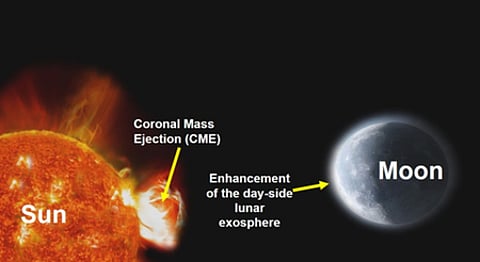

The Indian Space Research Organisation (ISRO) has confirmed that its Chandrayaan-2 lunar orbiter conducted the first direct observation of how solar activity, specifically Coronal Mass Ejections (CMEs), affects the Moon's exosphere.
This groundbreaking discovery provides unprecedented insight into lunar space weather and the dynamics of the Moon's extremely thin atmosphere.
Coronal Mass Ejections (CMEs) are massive bursts of plasma and magnetic field emitted from the Sun's corona, primarily containing hydrogen and helium ions.
When these ejections reach planetary bodies, they can have serious consequences. On Earth, they disrupt satellites and power grids. On the Moon, which lacks both an atmosphere and a global magnetic field, the consequences are even more direct and profound.
On May 10, 2024, a rare series of CMEs struck the Moon, allowing Chandra's Atmospheric Composition Explorer-2 (CHACE-2) to measure a significant increase in the total pressure of the sunlit lunar exosphere.
ISRO scientists reported that the number density of neutral atoms and molecules increased more than tenfold, confirming theoretical models that had previously lacked empirical support, Adda247 reports.
This observation confirmed that solar outbursts can significantly alter the Moon's atmospheric conditions by increasing the liberation of atoms from the surface.
These liberated atoms form part of the Moon's exosphere, which is a surface-boundary exosphere, meaning that the exosphere is directly influenced by the lunar surface conditions.
Unlike Earth, the Moon is airless and has no global magnetic field, making its exosphere extremely vulnerable to even minor fluctuations in solar activity. ISRO explains that solar radiation, solar wind, and meteorite impacts create and maintain the lunar exosphere.
When a CME occurs, it bombards the Moon with high-energy particles, which accelerate the process of knocking atoms and molecules off the lunar surface. These become part of the exosphere, temporarily increasing its density and pressure.
Despite the lander's unsuccessful touchdown attempt, Chandrayaan-2, which was launched in 2019, continues to yield scientific dividends via its orbiter.
CHACE-2, which builds on Chandrayaan-1, is proving to be an extremely useful tool for studying the lunar atmosphere.
